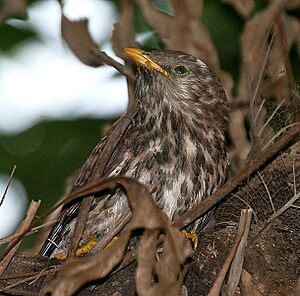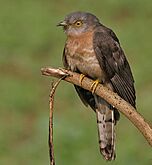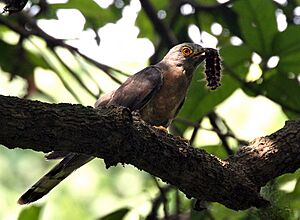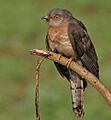Common hawk-cuckoo facts for kids
Quick facts for kids Common hawk-cuckoo |
|
|---|---|
 |
|
| Sub-adult |
|
| Conservation status | |
| Scientific classification | |
| Genus: |
Hierococcyx
|
| Species: |
varius
|
| Synonyms | |
|
Cuculus varius |
|
The common hawk-cuckoo (Hierococcyx varius) is a medium-sized bird. It lives in the Indian subcontinent. Many people know it as the brainfever bird. This name comes from its loud, repeated call during summer. The bird's call sounds like "brain-fever" and can be heard day and night.
This cuckoo looks a lot like a Shikra, which is a type of hawk. It even flies and lands like a hawk. Because it looks so much like a hawk, this group of cuckoos is called "hawk-cuckoos." Like many other cuckoos, it is a brood parasite. This means it lays its eggs in the nests of other birds, usually babblers.
Contents
What Does It Look Like?
The common hawk-cuckoo is about the size of a pigeon, around 34 centimeters long. Its back is grey, and its belly is whitish with brown stripes. Its tail has wide bars. Both male and female birds look similar. They have a bright yellow ring around their eyes.
Young hawk-cuckoos have streaks on their chest. They also have large brown marks on their belly. At first glance, they can easily be mistaken for a hawk. When they fly, they flap and glide like sparrowhawks, especially the shikra. When they land, they shake their tails from side to side. Many small birds and squirrels even give alarm calls, just as if a hawk were nearby!
It can be tricky to tell them apart from the large hawk-cuckoo. However, the large hawk-cuckoo has dark streaks on its throat and chest. Young common hawk-cuckoos have a pale chin. Young large hawk-cuckoos have a black chin.

During the summer, before the monsoon rains, males are easy to hear but hard to see. Their call is a loud, screaming three-note sound. It repeats 5 or 6 times, getting louder before suddenly stopping. You can hear it all day and often on moonlit nights. Female hawk-cuckoos make a series of rough, grating sounds.
Common hawk-cuckoos mostly eat insects. They are special eaters because they can handle hairy caterpillars. Caterpillars often have toxins in their guts. Like many cuckoos, they remove the guts. They do this by pressing the caterpillar and rubbing it on a branch. They swallow the hairs with the caterpillar. The hairs are then separated in their stomach and coughed up as a pellet.
Where Do They Live?
The common hawk-cuckoo lives in most of the Indian subcontinent. You can find them from Pakistan in the west to Nepal, Bhutan, Bangladesh, and North East India in the east. They also live south in Sri Lanka. Some birds from India fly to Sri Lanka for winter. In the hills of central Sri Lanka, a different type of common hawk-cuckoo lives there all year.
These birds usually stay in one place. But in high mountains or dry areas, they might move around. They live in lower areas of the Himalayas, usually below 1000 meters. Higher up, the large hawk-cuckoo is more common.
Common hawk-cuckoos live in trees and rarely go down to the ground. Their homes include gardens, groups of trees, and different types of forests.
How Do They Behave?
Like many other cuckoos, the common hawk-cuckoo is a brood parasite. This means it lays its eggs in the nests of other birds. They mostly choose babblers, especially those in the Turdoides group. They have also been known to use laughing-thrushes.
Their breeding season is from March to June. This is the same time that babblers breed. The cuckoo lays one blue egg in each host nest. The egg looks like the host's eggs. When the cuckoo chick hatches, it usually pushes the host's eggs out of the nest. The babbler parents then raise the cuckoo chick as their own. The young cuckoo stays with its foster parents for almost a month.
Sometimes, the cuckoo chick might not push out the host's eggs. Young cuckoos have been seen growing up alongside young babblers. When a cuckoo chick is with a group of babblers, it makes a rough "kee-kee" sound to ask for food. The foster parents in the group will feed it. In India, the main host birds are the Turdoides striatus and Turdoides affinis babblers. They also use the large grey babbler, Turdoides malcolmi. In Sri Lanka, their host is the Turdoides striatus.
The "Brainfever" Call
The call of this bird is famously known as "brain-fever" in English. Some old books mistakenly used this name for the Asian koel. One expert, Frank Finn, said its call truly deserves the name. He noted its "damnable iteration" (meaning it repeats a lot) and how much it sounds like "brain-fever" said in a high-pitched voice.
People in different languages have other ways to describe the call:
- In Hindi, it sounds like "piyaan kahan," meaning "where's my love."
- In Bengali, it's "chokh gelo," which means "my eyes are gone."
- In Marathi, it's "paos ala," meaning "the rains are coming."
- In Bodo, the call sounds like "haab fisha houwa," meaning "dear son (where are you)."
The call "Pee kahan" or "Papeeha" is actually more like the loud "pi-peeah" call of the large hawk-cuckoo (Hierococcyx sparverioides). That bird lives along the Himalayas.
The brainfever bird's call can be heard all day long. It starts early before dawn and often continues on moonlit nights. An Indian author, Allan Sealy, even named a novel after this bird. There is also a famous Bollywood song called "Bole Re Papihara" that talks about this bird and its clear call.
Images for kids








